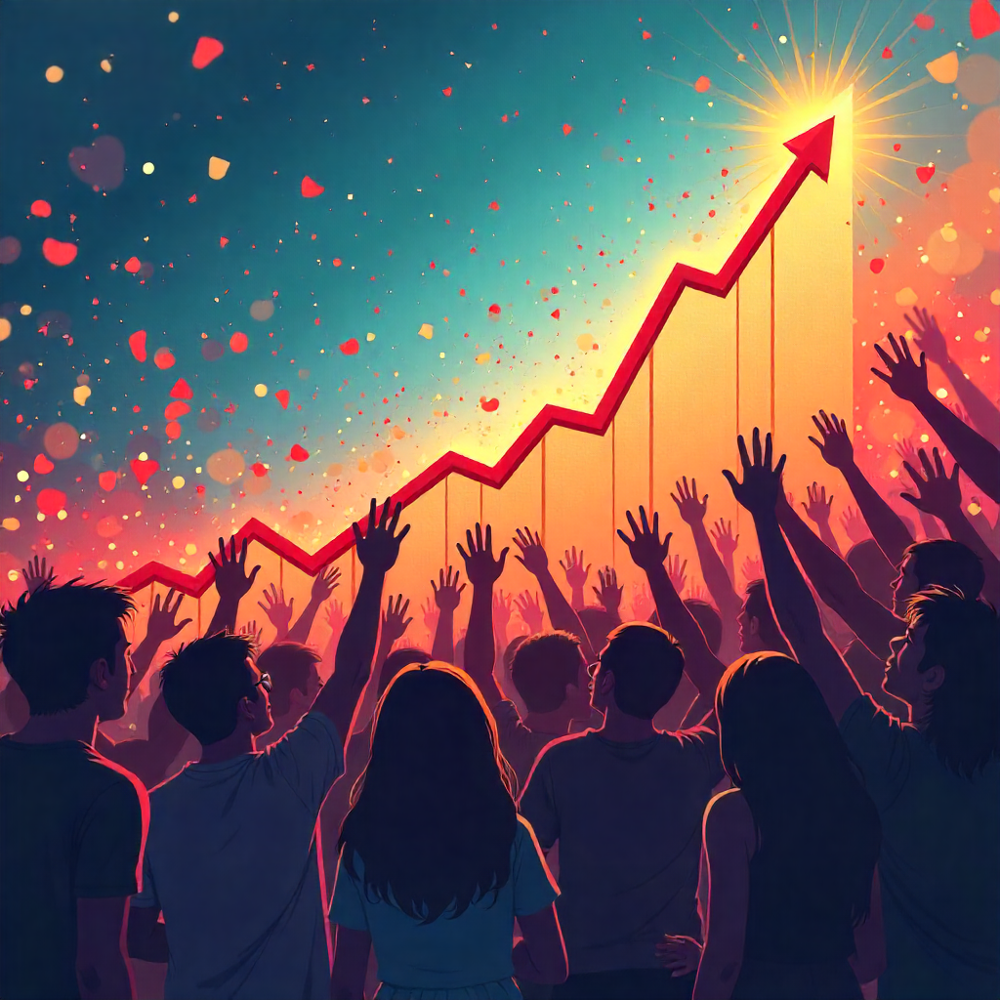Ostatnie dwa lata były jak kolejka górska dla każdego, kto śledzi swoje inwestycje. Po burzliwym 2023 roku, naznaczonym inflacją i podwyżkami stóp procentowych, lata 2024 i 2025 przyniosły niezwykłe odbicie. Indeksy takie jak S&P 500, europejski STOXX 600 czy polski WIG20 wspięły się na poziomy, których mało kto się spodziewał w czasach pandemicznej niepewności.
Dla milionów oszczędzających i inwestorów to długo wyczekiwana ulga. Emerytalne konta znów rosną, aplikacje inwestycyjne świecą się na zielono, a nawet ostrożni oszczędzający zaczynają wierzyć, że najgorsze już za nami. Jednak pod tą falą optymizmu kryje się cicha prawda: wraz z boomem na rynkach akcji przeciętny inwestor jest dziś bardziej wystawiony na ryzyko niż kiedykolwiek.
Rewolucja własności
W czasie pandemii i po niej zmienił się sposób, w jaki ludzie podchodzą do pieniędzy. Połączenie niskich stóp procentowych, łatwych w obsłudze aplikacji inwestycyjnych i popularności finansowych treści w mediach społecznościowych sprawiło, że miliony osób po raz pierwszy kupiły akcje lub fundusze ETF.
W Stanach Zjednoczonych dane Rezerwy Federalnej pokazują, że około 47 % majątku gospodarstw domowych jest obecnie powiązane z rynkiem akcji — to rekordowy udział. W Europie liczba ta jest niższa, ale rośnie szybko, szczególnie w krajach takich jak Polska, Niemcy i Holandia, gdzie młodsi inwestorzy coraz częściej korzystają z tanich platform maklerskich.
To zjawisko zdemokratyzowało inwestowanie w sposób, który jeszcze dekadę temu wydawał się nierealny. Jednak rozmyło też granicę między „inwestowaniem” a „oszczędzaniem”. Wielu ludzi traktuje dziś konto maklerskie jak konto oszczędnościowe — co jest zrozumiałe, ale ryzykowne, gdy rynki są blisko historycznych szczytów.
Urok hossy
Nie trudno zrozumieć, skąd ten entuzjazm. Indeksy biją rekordy, a wizja „miękkiego lądowania” gospodarki zyskuje na popularności. Banki centralne w USA i Europie zaczynają sygnalizować łagodzenie polityki pieniężnej. Giganci technologiczni znów raportują wysokie zyski, a sektory takie jak energia odnawialna, sztuczna inteligencja i obronność przyciągają ogromne kapitały.
W Polsce inwestorzy indywidualni wracają na warszawską giełdę w liczbach nienotowanych od połowy lat 2000. W Niemczech środki, które dotąd leżały bezczynnie na niskooprocentowanych kontach, płyną do funduszy ETF. W USA młodsze pokolenia zwiększają swoje wpłaty na 401(k) i konta inwestycyjne, często automatycznie.
Optymizm jest uzasadniony — ale tylko częściowo. Inwestowanie długoterminowe pozostaje jednym z najskuteczniejszych sposobów budowania majątku. Problem w tym, że psychologia rynku bywa zdradliwa: gdy ceny rosną, łatwo zapomnieć, że spadki też są częścią cyklu.
Ukryte ryzyka sukcesu
Doradcy finansowi często powtarzają, że największe ryzyko pojawia się wtedy, gdy czujemy się najbezpieczniej. I właśnie teraz żyjemy w takim momencie.
Kiedy portfele gospodarstw domowych stają się zbyt mocno skoncentrowane na akcjach, 20-procentowy spadek giełdy może wymazać lata zysków. Efekt bogactwa — uczucie, że jesteśmy zamożniejsi, gdy rynki rosną — zachęca do wydawania pieniędzy i zmniejszania oszczędności. Gdy trend się odwraca, spadek pewności siebie może gwałtownie uderzyć w budżety domowe.
W krajach takich jak Polska ekspozycja jest szczególnie wrażliwa. Mniejszy odsetek gospodarstw domowych posiada akcje bezpośrednio, ale ci, którzy inwestują, często robią to przez fundusze silnie powiązane z lokalnym rynkiem. W efekcie brakuje im globalnej dywersyfikacji.
Globalne powiązania, wspólne ryzyka
Globalizacja inwestycji sprawiła, że wstrząsy finansowe nie znają granic. Decyzja Rezerwy Federalnej może w ciągu kilku godzin odbić się na rynkach we Frankfurcie, Londynie i Warszawie. I odwrotnie — problemy w europejskim przemyśle lub kryzys energetyczny potrafią osłabić nastroje na Wall Street.
Rosnąca popularność funduszy ETF tylko ten efekt pogłębia. Wielu inwestorów uważa, że są zdywersyfikowani, podczas gdy w rzeczywistości trzymają udziały w tych samych globalnych spółkach technologicznych czy energetycznych.
Lekcje dla inwestorów
Jak więc rozsądnie poruszać się po tym rynku? Nie chodzi o ucieczkę z giełdy, ale o zachowanie równowagi i świadomości.
- Zrewiduj swój apetyt na ryzyko.
To, co było komfortowe dwa lata temu, może już nie być odpowiednie. Jeśli 15 % spadek rynku spędza ci sen z powiek — czas na korektę portfela. - Dywersyfikuj naprawdę.
Prawdziwa dywersyfikacja to nie tylko różne fundusze, ale różne klasy aktywów — akcje, obligacje, gotówka, nieruchomości. - Nie gonić za modą.
Branże takie jak AI czy zielona energia są obiecujące, ale często już mocno wycenione. Inwestuj z planem, nie z emocji. - Zachowaj płynność.
Fundusz awaryjny (3–6 miesięcy wydatków) to konieczność. Pozwala uniknąć sprzedaży inwestycji w złym momencie. - Myśl globalnie, działaj lokalnie.
Globalny portfel nie wyklucza lokalnych inwestycji. Obligacje skarbowe czy konta oszczędnościowe mogą dać stabilność i ochronę przed inflacją. - Czas w rynku jest ważniejszy niż wyczucie czasu.
Najlepsi inwestorzy nie przewidują każdego ruchu rynku — po prostu pozostają konsekwentni mimo wahań.
Emocjonalna strona inwestowania
Nie można zapominać o psychologii. Euforia giełdowa bywa uzależniająca, a media społecznościowe potęgują to uczucie, pokazując jedynie sukcesy. Jednak to właśnie zdolność zachowania spokoju w trudnych chwilach odróżnia inwestorów długoterminowych od tych, którzy odpadają w panice.
Patrząc w przyszłość
Wchodząc w 2026 rok, świat finansów balansuje na delikatnej granicy. Banki centralne starają się wspierać wzrost, nie dopuszczając do ponownej fali inflacji. Technologie zmieniają gospodarkę szybciej niż kiedykolwiek, a inwestorzy na całym świecie są bardziej połączeni — i bardziej narażeni — niż kiedykolwiek wcześniej.
Globalna hossa 2025 roku przypomina, że dobrobyt i ryzyko idą w parze. Dla wielu rodzin to czas na radość, ale też na refleksję i przygotowanie na przyszłość.
Bo prawdziwe bezpieczeństwo finansowe nie polega na przewidywaniu każdego zwrotu rynku — lecz na budowaniu odporności, która pozwoli przetrwać każdy kryzys.
